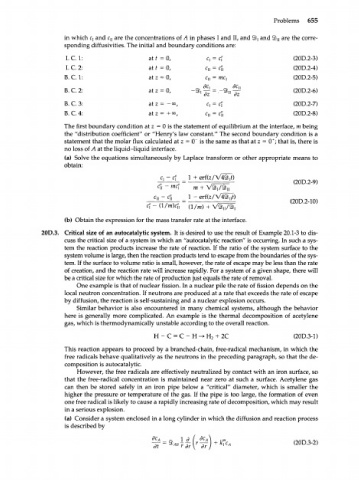Page 675 - Bird R.B. Transport phenomena
P. 675
Problems 655
in which Cj and c u are the concentrations of A in phases I and II, and 2), and 2),, are the corre-
sponding diffusivities. The initial and boundary conditions are:
I.C.I: atf=O, c, = cf (20D.2-3)
I. C. 2: at t = 0, c u = c° u (20D.2-4)
В. С 1 : at z = 0, c = mc (20D.2-5)
u }
B.C. 2: atz = 0, -% ^ = -% ^ (20D.2-6)
{
В. С 3: at z = - oo, C | = c? (20D.2-7)
В. С 4: at z = + oo, Cll = c° n (20D.2-8)
The first boundary condition at z = 0 is the statement of equilibrium at the interface, m being
the "distribution coefficient" or "Henry's law constant." The second boundary condition is a
+
statement that the molar flux calculated at z = 0~ is the same as that at z = 0 ; that is, there is
no loss of A at the liquid-liquid interface.
(a) Solve the equations simultaneously by Laplace transform or other appropriate means to
obtain:
(20D.2-9)
(20D.2-10)
(b) Obtain the expression for the mass transfer rate at the interface.
20D.3. Critical size of an autocatalytic system. It is desired to use the result of Example 20.1-3 to dis-
cuss the critical size of a system in which an "autocatalytic reaction" is occurring. In such a sys-
tem the reaction products increase the rate of reaction. If the ratio of the system surface to the
system volume is large, then the reaction products tend to escape from the boundaries of the sys-
tem. If the surface to volume ratio is small, however, the rate of escape may be less than the rate
of creation, and the reaction rate will increase rapidly. For a system of a given shape, there will
be a critical size for which the rate of production just equals the rate of removal.
One example is that of nuclear fission. In a nuclear pile the rate of fission depends on the
local neutron concentration. If neutrons are produced at a rate that exceeds the rate of escape
by diffusion, the reaction is self-sustaining and a nuclear explosion occurs.
Similar behavior is also encountered in many chemical systems, although the behavior
here is generally more complicated. An example is the thermal decomposition of acetylene
gas, which is thermodynamically unstable according to the overall reaction.
H - C = C - H ^ H 2 + 2C (20D.3-1)
This reaction appears to proceed by a branched-chain, free-radical mechanism, in which the
free radicals behave qualitatively as the neutrons in the preceding paragraph, so that the de-
composition is autocatalytic.
However, the free radicals are effectively neutralized by contact with an iron surface, so
that the free-radical concentration is maintained near zero at such a surface. Acetylene gas
can then be stored safely in an iron pipe below a "critical" diameter, which is smaller the
higher the pressure or temperature of the gas. If the pipe is too large, the formation of even
one free radical is likely to cause a rapidly increasing rate of decomposition, which may result
in a serious explosion.
(a) Consider a system enclosed in a long cylinder in which the diffusion and reaction process
is described by
--
%Н(%)«<* (20D 3 2)

